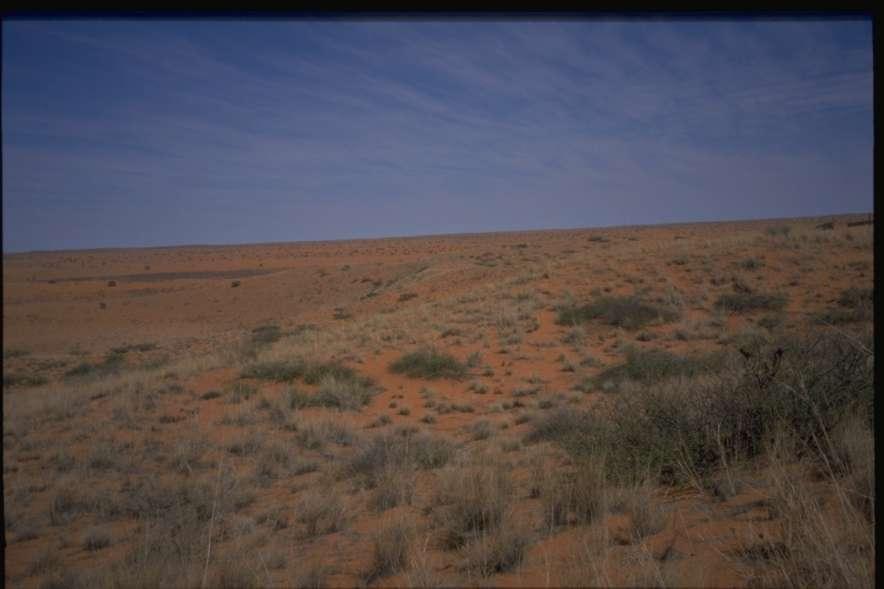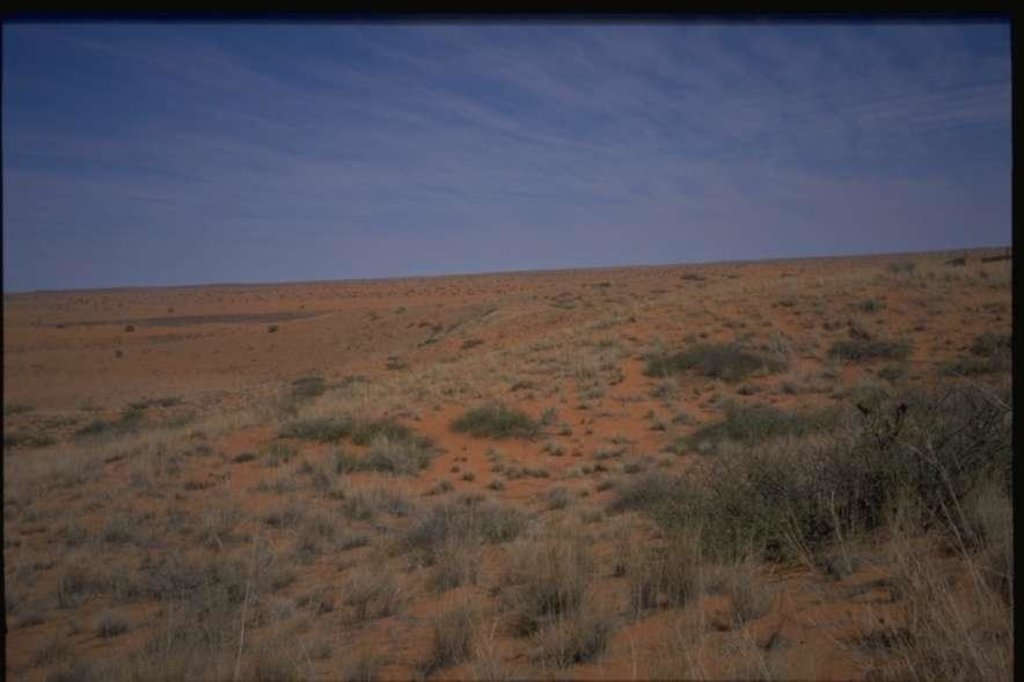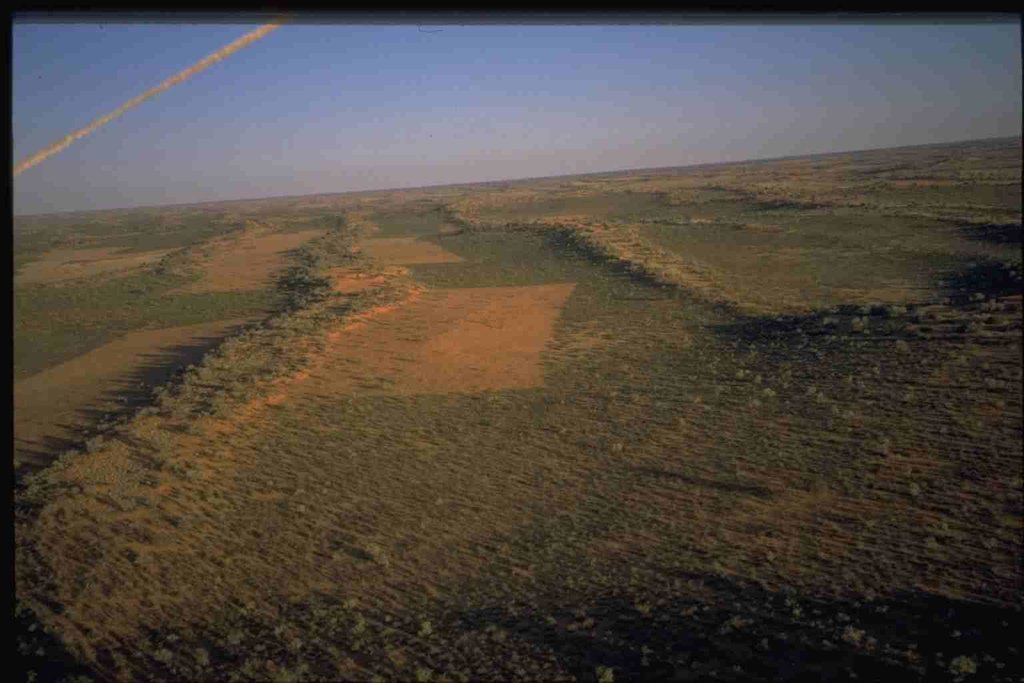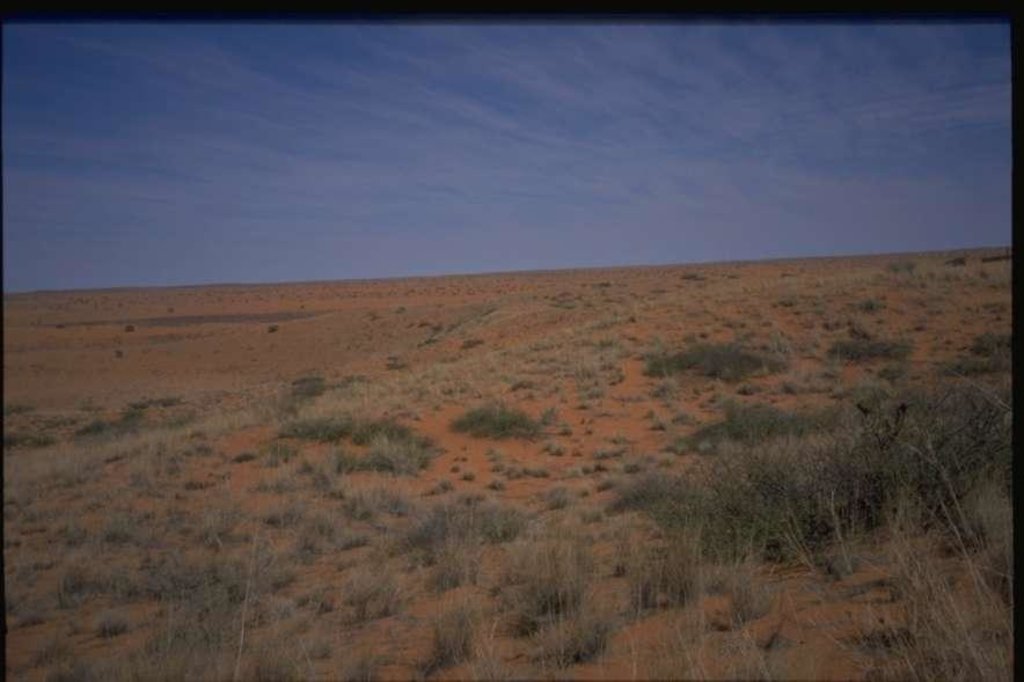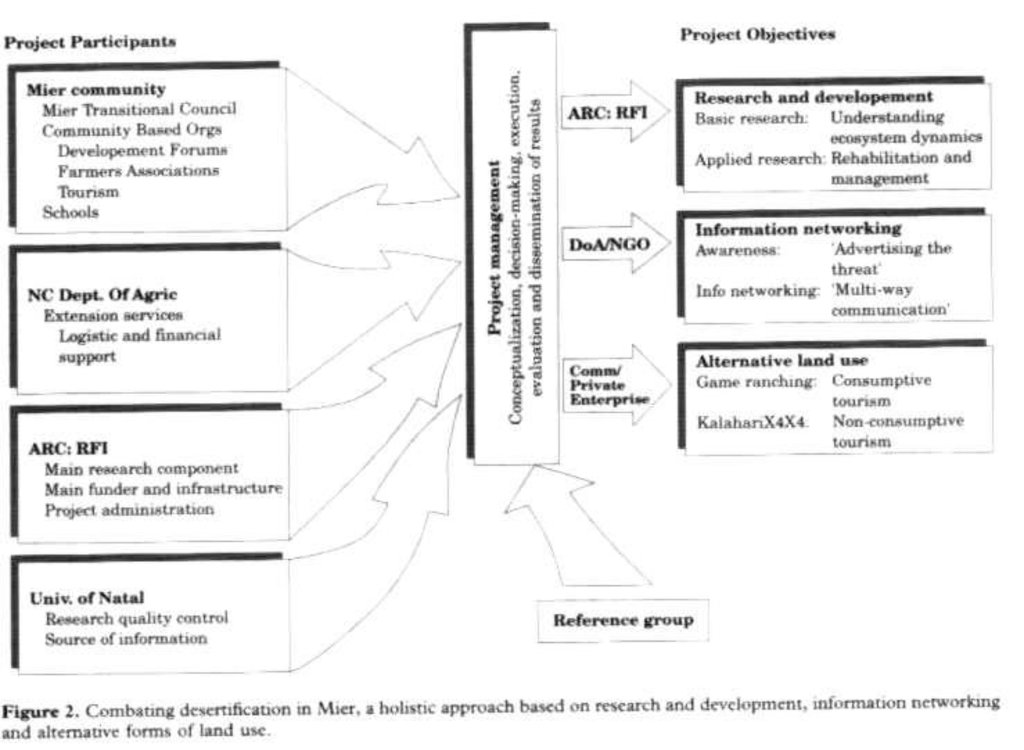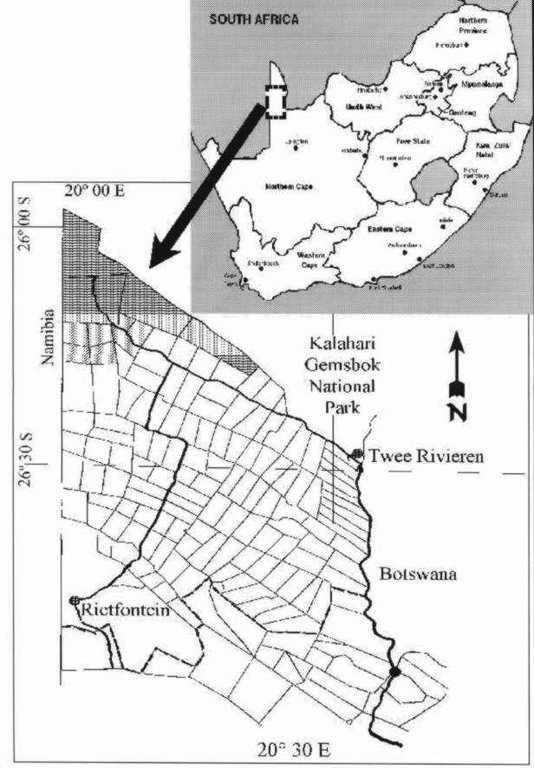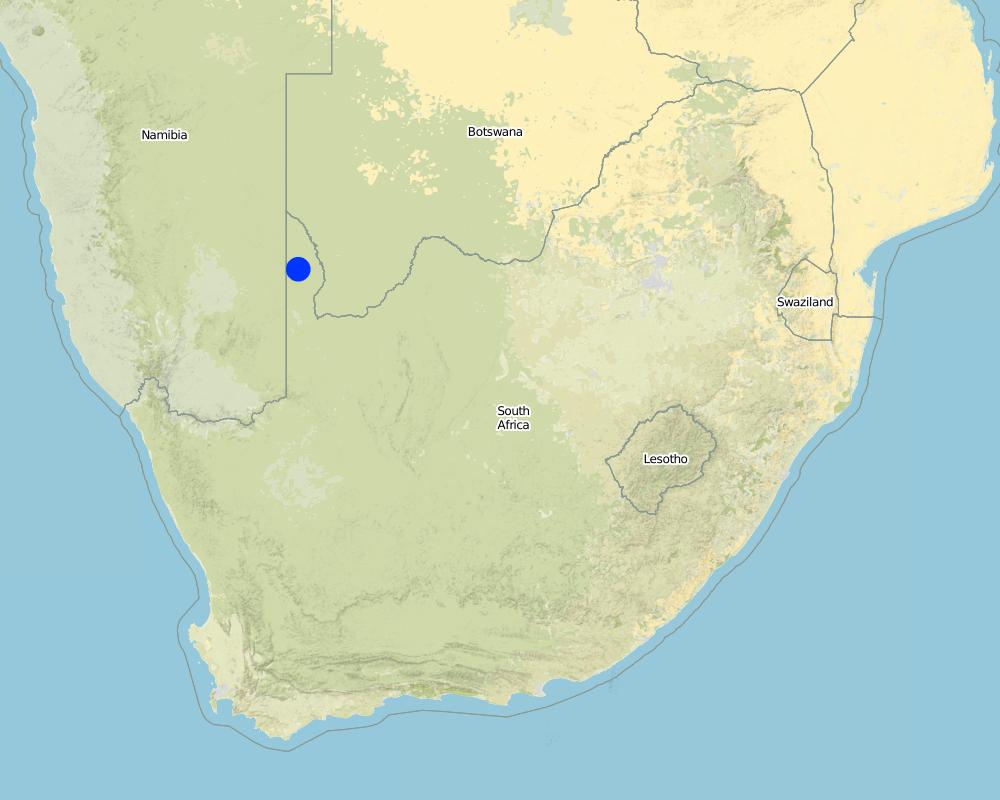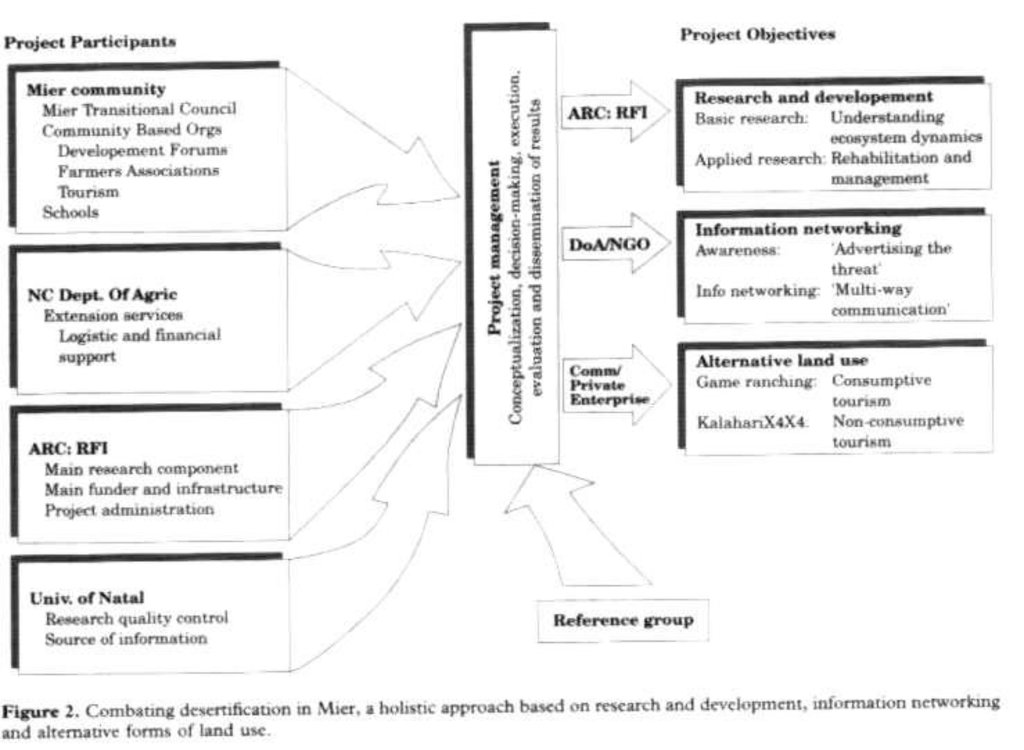Rehabilitation techniques in southern Kalahari - Vegetative and Management [Afrique du Sud]
- Création :
- Mise à jour :
- Compilateur : Andre F. Van Rooyen
- Rédacteur : –
- Examinateur : Fabian Ottiger
approaches_2335 - Afrique du Sud
Voir les sections
Développer tout Réduire tout1. Informations générales
1.2 Coordonnées des personnes-ressources et des institutions impliquées dans l'évaluation et la documentation de l'Approche
Spécialiste GDT:
Smith Desmond
054-4611415
Northern Cape. Department of Agriculture
Afrique du Sud
Nom du ou des institutions qui ont facilité la documentation/ l'évaluation de l'Approche (si pertinent)
Dept. of Agriculture, Northern Cape (Dept. of Agriculture, Northern Cape) - Afrique du Sud1.3 Conditions relatives à l'utilisation par WOCAT des données documentées
Le compilateur et la(les) personne(s) ressource(s) acceptent les conditions relatives à l'utilisation par WOCAT des données documentées:
Oui
2. Description de l'Approche de GDT
2.1 Courte description de l'Approche
Shared interest by Mier Management Council and Provincial Department of Agriculture
2.2 Description détaillée de l'Approche
Description détaillée de l'Approche:
Aims / objectives: Initially a combined effort by Department of Agriculture and Mier Management Council to combat degradation of game camps. Directed towards a male dominated farming community, also involving a few females (ages ranging from middle to old age). An objective was to educate towards awareness to degradation and techniques involving the rehabilitation of these areas and the prevention of getting to this state. Also including methods which prevent returning to this state. Initially using farmer???s days - education. Research came later, focussing on understanding the ecology of the area and then to concentrate on rehabilitation techniques. This was later introduced in farmer???s days, school education and education of management council. Stages of implementation: 1) Realisation by management council that veld was degraded. 2) Department of Agriculture requested to assist ??¡§ in the form of trial and error (i.e. resting camps, poisoning of shrubs). 3) Resting of camps showed no improvement, so Department requested assistance from Agricultural Research Council (Range and Forage Institute) to gain understanding of ecology of area. 4) Once understanding gained and techniques developed, education in the form of farmer???s days, school days and management council. Role of participants: 1) Nature Conservation: Initially involved in game number management. 2) Department of Agriculture: Advisory capacity management of techniques. 3) ARC - Research and advisory. 4) Management council ??¡§ labour control. 5) Community - involved through council in decision-making ??¡§ also jobs provided through labour.
2.3 Photos de l'approche
2.5 Pays/ région/ lieux où l'Approche a été appliquée
Pays:
Afrique du Sud
Région/ Etat/ Province:
Northern Cape
Map
×2.6 Dates de début et de fin de l'Approche
Indiquez l'année de démarrage:
1988
2.7 Type d'Approche
- fondé sur un projet/ programme
2.8 Principaux objectifs de l'Approche
The Approach focused mainly on SLM with other activities (Income generation for tax subsidy in the community, job creation for males in the community, land care, development of eco-tourism, collaboration with local leadership)
Education ??¡§ in techniques to combat desertification, also in prevention of degradation Financial empowerment Management techniques
The SLM Approach addressed the following problems: Finance, education (very little education with regards to labours)
2.9 Conditions favorisant ou entravant la mise en œuvre de la(des) Technologie(s) appliquée(s) sous l'Approche
disponibilité/ accès aux ressources et services financiers
- entrave
Very poor community
Treatment through the SLM Approach: Landcare (money)
cadre institutionnel
- entrave
Financial - no money in Institute and Department
Treatment through the SLM Approach: Money
cadre juridique (régime foncier, droits d'utilisation des terres et de l'eau)
- favorise
The existing land ownership, land use rights / water rights moderately helped the approach implementation: Hinder: moderate Farm-government won???t allow farmers to own land so attitude can be negative. Community reaps benefits from game farms.
autre
- entrave
Political: leads to mistrust and uneasiness w.r.t. Money
Treatment through the SLM Approach: Work on the problem at hand and ignore politics
3. Participation et rôles des parties prenantes impliquées dans l'Approche
3.1 Parties prenantes impliquées dans l'Approche et rôles
- exploitants locaux des terres / communautés locales
Working land users were mainly men (Women did not work on project because of long distance to work).
Labour, management.
Labour work far too heavy for women (injuries have occurred). Women are directed towards cultivation techniques of Harpagophytum procumbens or basic homeskills (sewing etc.) Males - chopping & packing Rhigozum on dunes (degraded dunes).
- enseignants/ élèves/ étudiants
- ONG
Research, management, education
- gouvernement national (planificateurs, décideurs)
Funding
3.2 Participation des exploitants locaux des terres/ communautés locales aux différentes phases de l'Approche
| Participation des exploitants locaux des terres/ communautés locales | Spécifiez qui était impliqué et décrivez les activités | |
|---|---|---|
| initiation/ motivation | passive | workshops/seminars, public meetings; Discussions to indicate where researchers see the project going and how the land users would like to see it go. |
| planification | interactive | workshops/seminars, public meetings; Field workshops & meetings-discuss how and where the project should be carried out. |
| mise en œuvre | soutien extérieur | responsibility for major steps; Labour used for bushpacking responsibility for LandCare committee for salaries and labour. |
| suivi/ évaluation | aucun | public meetings,measurements/observations, reporting, workshop/seminars; Monitoring of project is on going by researchers with help of few labours. Congresses/workshops are used to describe process & public meetings allow community to be informed. |
| Research | aucun | on-station; On-farm & on-station is ongoing. Lab work for information on germination processes. |
3.3 Diagramme/ organigramme (si disponible)
3.4 Prises de décision pour la sélection de la Technologie/ des Technologies
Indiquez qui a décidé de la sélection de la Technologie/ des Technologies à mettre en œuvre:
- principalement les spécialistes de la GDT, après consultation des exploitants des terres
Expliquez:
land user driven (bottom-up). Knowledge of the area
Decisions on the method of implementing the SLM Technology were made by mainly by SLM specialists with consultation of land users. directive (top-down). Management due to low education
4. Soutien technique, renforcement des capacités et gestion des connaissances
4.1 Renforcement des capacités/ formation
Une formation a-t-elle été dispensée aux exploitants des terres/ autres parties prenantes?
Oui
Spécifiez qui a été formé:
- exploitants des terres
- school children/students, planners, politicians/decision makers
Formats de la formation:
- entre agriculteurs (d'exploitants à exploitants)
- zones de démonstration
Thèmes abordés:
Rehabilitation ecological processes, cultivation, preventative agriculture
4.2 Service de conseils
Les exploitants des terres ont-ils accès à un service de conseils?
Oui
Spécifiez si le service de conseils est fourni:
- dans les champs des exploitants?
- dans des centres permanents
Décrivez/ commentez:
Name of method used for advisory service: Not formal approach; Key elements: Education, Labour, Development; 1) Advisory service was carried out through: government's existing extension system Extension staff: mainly government employees 3) Target groups for extension: land users, school children/students; Activities: Bushpacking techniques, education; Education
Advisory service is inadequate to ensure the continuation of land conservation activities; The project is still in first phase - next phase will include female portion of community.
4.3 Renforcement des institutions (développement organisationnel)
Des institutions ont elles été mises en place ou renforcées par le biais de l'Approche?
- oui, un peu
Spécifiez à quel(s) niveau(x), ces institutions ont été renforcées ou mises en place:
- local
Précisez le type de soutien:
- équipement
- advise
4.4 Suivi et évaluation
Le suivi et l'évaluation font ils partie de l'Approche? :
Oui
Commentaires:
bio-physical aspects were regular monitored through measurements
technical aspects were ad hoc monitored through observations
socio-cultural aspects were ad hoc monitored hrough observations
economic / production aspects were regular monitored through measurements
area treated aspects were regular monitored through measurements
no. of land users involved aspects were ad hoc monitored through observations
management of Approach aspects were ad hoc monitored through observations
There were few changes in the Approach as a result of monitoring and evaluation: Packing designs of Rhigozum plants on bare dunes. The less expensive, most efficient design was chosen.
4.5 Recherche
La recherche a-t-elle fait partie intégrante de l’Approche?
Oui
Spécifiez les thèmes:
- écologie
Donnez plus de détails et indiquez qui a mené ces recherches:
Rehabilitation techniques must fall within the capabilities and finance of the community.
Research was carried out on-farm
5. Financement et soutien matériel externe
5.1 Budget annuel de la composante GDT de l'Approche
Commentez (par ex. principales sources de financement/ principaux bailleurs de fonds):
Approach costs were met by the following donors: government (national): 80.0%; local community / land user(s) (-): 20.0%
5.2 Soutiens financiers/ matériels fournis aux exploitants des terres
Les exploitants des terres ont-ils reçu un soutien financier/ matériel pour la mise en œuvre de la Technologie/ des Technologies?
Oui
5.3 Subventions pour des intrants spécifiques (incluant la main d'œuvre)
- équipement
| Spécifiez les intrants subventionnés | Dans quelle mesure | Spécifiez les subventions |
|---|---|---|
| machines | entièrement financé | |
| outils | entièrement financé | |
- intrants agricoles
| Spécifiez les intrants subventionnés | Dans quelle mesure | Spécifiez les subventions |
|---|---|---|
| semences | entièrement financé | |
| fertilisants | entièrement financé | |
- autre
| Autre (spécifiez) | Dans quelle mesure | Spécifiez les subventions |
|---|---|---|
| Food and transport | entièrement financé |
Si la main d'œuvre fournie par les exploitants des terres était un intrant substantiel, elle était:
- payée en espèces
6. Analyses d'impact et conclusions
6.1 Impacts de l'Approche
Est-ce que l'Approche a aidé les exploitants des terres à mettre en œuvre et entretenir les Technologies de GDT?
- Non
- Oui, un peu
- Oui, modérément
- Oui, beaucoup
Stabilisation of dunes, greater vegetation on dunes.
Est-ce que l'Approche a amélioré les questions foncières et des droits d'utilisation qui entravent la mise en œuvre des Technologies?
- Non
- Oui, un peu
- Oui, modérément
- Oui, beaucoup
Farmers realised the simplicity of rehabilitation. The problem is likely to be overcome in the near future. Attitudes would change if government allowed ownership of land.
Did other land users / projects adopt the Approach?
- Non
- Oui, un peu
- Oui, modérément
- Oui, beaucoup
South Africa railways - lines which cut through dune systems
6.3 Durabilité des activités de l'Approche
Les exploitants des terres peuvent-ils poursuivre ce qui a été mis en œuvre par le biais de l'Approche (sans soutien extérieur)?
- oui
6.4 Points forts/ avantages de l'Approche
| Points forts/ avantages/ possibilités du point de vue de l'exploitant des terres |
|---|
| Own input into R &D |
| Points forts/ avantages/ possibilités du point de vue du compilateur ou d'une autre personne ressource clé |
|---|
| Community participation (How to sustain/ enhance this strength: Greater responsibility to community) |
| Healthy integration of Scientists & Community action (How to sustain/ enhance this strength: Good communication (Scientists & Community)) |
6.5 Faiblesses/ inconvénients de l'Approche et moyens de les surmonter
| Faiblesses/ inconvénients/ risques du point de vue de l’exploitant des terres | Comment peuvent-ils être surmontés? |
|---|---|
| I do not know |
| Faiblesses/ inconvénients/ risques du point de vue du compilateur ou d'une autre personne ressource clé | Comment peuvent-ils être surmontés? |
|---|---|
| Slow recovery of natural resources | I don't think there is a way to increase reaction time in this area |
7. Références et liens
7.1 Méthodes/ sources d'information
- visites de terrain, enquêtes sur le terrain
- interviews/entretiens avec les exploitants des terres
Liens et modules
Développer tout Réduire toutLiens
Aucun lien
Modules
Aucun module trouvé


